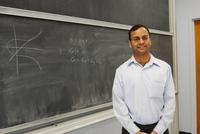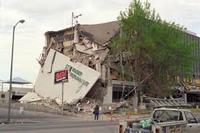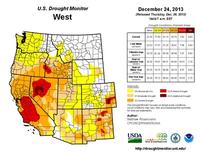-
NSF rapid response research grants to fund study of West Virginia chemical spill
On 9 January 2014, crude 4-methylcyclohexane methanol (MCHM), a chemical primarily used to clean coal, leaked from a storage tank near Charleston, West Virginia, and bled into a river upstream of a water-treatment plant. As a result, about 15 percent of the state’s residents were advised not to drink the water. Better to understand the properties of the chemical that contaminated the drinking water, and the plumbing and water-treatment systems surrounding the area, the National Science Foundation (NSF) has awarded Rapid Response Research (RAPID) grants to research teams at three universities. These grants also will provide STEM learning opportunities for undergraduate and graduate students on the research teams.
-
-
Coastal areas must adapt to sea-level rise and storm surges or suffer massive damage
A new study presents, for the first time, comprehensive global simulation results on future flood damages to buildings and infrastructure in coastal flood plains. Drastic increases in these damages are expected due to both rising sea levels and population and economic growth in the coastal zone. Asia and Africa may be particularly hard hit because of their rapidly growing coastal mega-cities, such as Shanghai, Manila, and Lagos.
-
-
Attack on California power station heightens concerns about grid security
Security experts are concerned that last year’s unsolved attack on an electrical-power substation in San Jose, California, is but a prologue to similar attacks which, if executed simultaneously and in a coordinated fashion against several such substations, could cripple the U.S. power grid. The transformers at the substation, vital for regional power distribution, were shot at by several gunmen and disabled for twenty-seven days. What is especially worrisome, security exert note, is that the attack appeared to have been carried out by people with some training, although the FBI said the agency does not think it was the act of terrorists.
-
-
New software obfuscation system a cryptography game changer

A team of researchers has designed a system to encrypt software so that it only allows someone to use a program as intended while preventing any deciphering of the code behind it. This is known in computer science as “software obfuscation,” and it is the first time it has been accomplished. Previously developed techniques for obfuscation presented only a “speed bump,” forcing an attacker to spend some effort, perhaps a few days, trying to reverse-engineer the software. The new system puts up an “iron wall,” making it impossible for an adversary to reverse-engineer the software without solving mathematical problems that take hundreds of years to work out on today’s computers — a game-change in the field of cryptography.
-
-
U.S. Navy probes exam cheating at school for nuclear power reactor operator
Yet another military service is facing allegations of exam-cheating. Earlier this year, the U.S. Air Force launched a probe into a cheating scandal involving about 100 officersat Malmstrom Air Force Base, Montana, who are responsible for maintaining and operating land-based nuclear missiles. Now the U.S. Navy is investigating about one-fifth of its trainers at the school for naval nuclear power reactor operators in Charleston, South Carolina. The sailors are accused of cheating on written tests required to obtain certification as instructors at the nuclear propulsion school.
-
-
New state-of-the-art cybersecurity resource available to software developers
Cybercrime is booming; it is an estimated $100 billion industry in the United States and shows no signs of slowing down. Attackers have an arsenal of weapons at their disposal, including social engineering — or phishing — penetrating weak security protocols and exploiting software vulnerabilities that can serve as an “open window” into an organization’s IT environment. Closing those windows requires effective and accessible tools to identify and root out software vulnerabilities. Supported by a $23.4 million grant from DHS’s Science and Technology Directorate (S&T), the Software Assurance Marketplace, or SWAMP, provides a state-of-the-art facility that serves as an open resource for software developers, software assurance tool developers, and software researchers who wish to collaborate and improve software assurance activities in a safe, secure environment.
-
-
Quake-vulnerable concrete buildings in Los Angeles area identified

Researchers have identified nonductile concrete buildings constructed before roughly 1980 in the Los Angeles area. This category of buildings is known from experience in previous earthquakes to have the potential for catastrophic collapse during strong earthquakes. Nonductile concrete buildings were a prevalent construction type in seismically active zones of the United States before the enforcement of codes for ductile concrete which were introduced in the mid-1970s. A companion study estimates that approximately 17,000 nonductile reinforced concrete buildings are located in the most highly seismic areas of California. More than seventy-five million Americans in thirty-nine states live in towns and cities at risk for earthquake devastation.
-
-
New biofuel sources does not require farmland

While the debate over using crops for fuel continues, scientists are now reporting a new, fast approach to develop biofuel in a way that does not require removing valuable farmland from the food production chain. Their work examines the fuel-producing potential of Streptomyces, a soil bacterium known for making antibiotics.
-
-
DARPA makes agency-sponsored software, publications available to R&D community
DARPA has invested in many programs that sponsor fundamental and applied research in areas of computer science, programs which have led to new advances in theory as well as practical software. The R&D community has asked about the availability of results, and now DARPA has responded by creating the DARPA Open Catalog, a place for organizing and sharing those results in the form of software, publications, data, and experimental details. The Web site aims to encourage communities interested in DARPA research to build off the agency’s work, starting with big data.
-
-
Protecting cities from floods cheaper than post-flood damage repairs

Researchers say that global warming is here to stay, and thus it is time to start making plans for dealing with the inevitable flooding which will occur as ocean levels rise as a result of warmer water and melting snow and ice. Approximately a billion people currently live in areas which are most at risk — low-lying coastal areas. It is not likely that towns and cities will be moved farther inland, so other measures need to be taken. The researchers say that flood prevention strategies are well established, for example, building levees, barrier islands, etc., so it is not difficult to draw up estimates for such schemes for individual areas.
-
-
Total California water supplies at near-decade low

Advisory from UC Center for Hydrologic Modeling finds California’s statewide averages of snow, surface water, and soil moisture near 10-year lows. The threat of multi-year period of unsustainable groundwater depletion imminent if drought continues. The data show particularly steep water losses between November 2011 and November 2013, the early phase of the current drought. The researchers estimate that the Sacramento and San Joaquin River basins have already lost ten cubic kilometers of fresh water in each of the last two years — equivalent to virtually all of California’s urban and household water use each year.
-
-
Aging grid cannot keep up with growing demand for electricity
The demand for electricity in the United States increased by around 20 percent from 1999 to 2009, but transmission capacity only increased by around 7 percent in that time. From 2000 to 2004, there were 140 instances of power outages which each affected 50,000 or more consumers. This number increased to 303 from 2005 to 2009. Between 2010 and 2012, there were 226 such outages. The average age of a power plant is 30-years old, and around 75 percent of America’s power lines are 25-years old. Economists estimate that these power outages cost the country more than $70 billion in annual economic loss.
-
-
Making the U.S. grid sturdier, smarter, and more secure to thwart blackouts

In August 2003, fifty million customers throughout the northeastern United States and southeastern Canada lost power for up to two days. More than ten years later, the U.S. electric power system continues to be challenged. In the United States, 149 power outages affecting at least 50,000 customers occurred between 2000 and 2004, a number which grew to 349 between 2005 and 2009. In 2012, the prolonged power outages in New York and New Jersey caused by Hurricane Sandy once again demonstrated the system’s vulnerability. A broad, multidisciplinary effort by Georgia Tech researchers aims to revolutionize the delivery of electricity, advance the smart grid, thwart blackouts, integrate renewable energy sources, and secure utilities from cyberattacks.
-
-
Chemical, defense companies subject to Chinese Nitro attacks
More and more chemical and defense companies around the world are victims of Nitro attacks. These attacks, launched by government-backed Chinese hackers, install PoisonIvy, a Remote Access Tool (RAT) stealthily placed on computer systems to steal information. The majority of the computers infected belong to firms in the United States, Bangladesh, and the United Kingdom.
-
-
National Guard units help states ward off cyberattacks
Governors across the United States are mobilizing their states’ National Guard units to combat threats from cyberattacks. The state of Washington was the first state to assign the state’s National Guard cybersecurity responsibilities. The state recognized the potential of its National Guard as a cyberforce when it realized that many of its soldiers, who are full-time employees and part-time soldiers, worked for tech employers such as Google, Boeing, Cisco, Verizon, and Microsoft.
-
More headlines
The long view
Water Wars: A Historic Agreement Between Mexico and US Is Ramping Up Border Tension
As climate change drives rising temperatures and changes in rainfall, Mexico and the US are in the middle of a conflict over water, putting an additional strain on their relationship. Partly due to constant droughts, Mexico has struggled to maintain its water deliveries for much of the last 25 years, deliveries to which it is obligated by a 1944 water-sharing agreement between the two countries.
Trump Is Fast-Tracking New Coal Mines — Even When They Don’t Make Economic Sense
In Appalachian Tennessee, mines shut down and couldn’t pay their debts. Now a new one is opening under the guise of an “energy emergency.”
Smaller Nuclear Reactors Spark Renewed Interest in a Once-Shunned Energy Source
In the past two years, half the states have taken action to promote nuclear power, from creating nuclear task forces to integrating nuclear into long-term energy plans.
Keeping the Lights on with Nuclear Waste: Radiochemistry Transforms Nuclear Waste into Strategic Materials
How UNLV radiochemistry is pioneering the future of energy in the Southwest by salvaging strategic materials from nuclear dumps –and making it safe.
Model Predicts Long-Term Effects of Nuclear Waste on Underground Disposal Systems
The simulations matched results from an underground lab experiment in Switzerland, suggesting modeling could be used to validate the safety of nuclear disposal sites.
